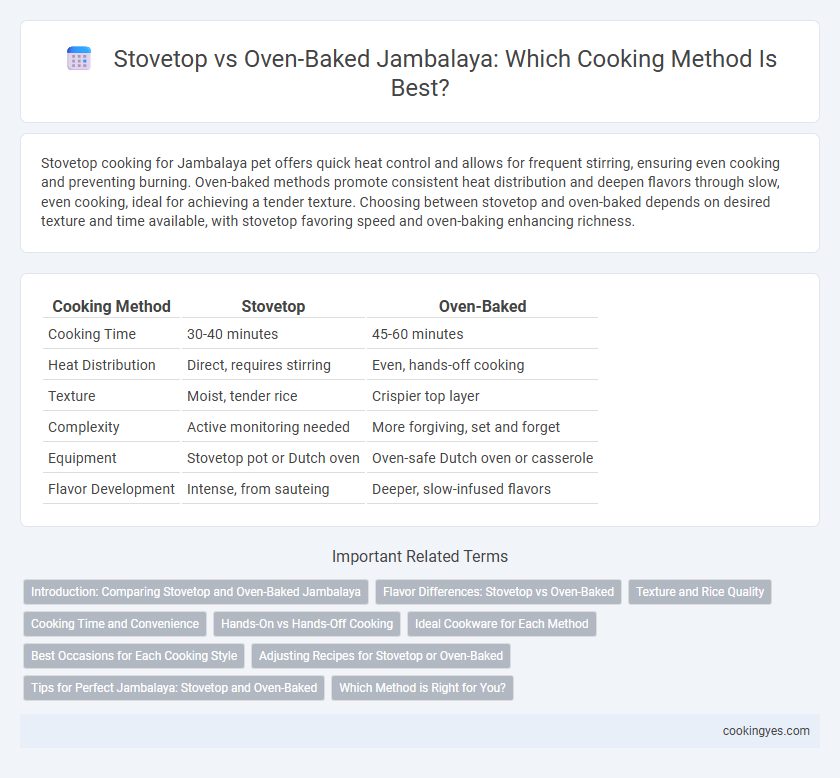Stovetop cooking for Jambalaya pet offers quick heat control and allows for frequent stirring, ensuring even cooking and preventing burning. Oven-baked methods promote consistent heat distribution and deepen flavors through slow, even cooking, ideal for achieving a tender texture. Choosing between stovetop and oven-baked depends on desired texture and time available, with stovetop favoring speed and oven-baking enhancing richness.
Table of Comparison
| Cooking Method | Stovetop | Oven-Baked |
|---|---|---|
| Cooking Time | 30-40 minutes | 45-60 minutes |
| Heat Distribution | Direct, requires stirring | Even, hands-off cooking |
| Texture | Moist, tender rice | Crispier top layer |
| Complexity | Active monitoring needed | More forgiving, set and forget |
| Equipment | Stovetop pot or Dutch oven | Oven-safe Dutch oven or casserole |
| Flavor Development | Intense, from sauteing | Deeper, slow-infused flavors |
Introduction: Comparing Stovetop and Oven-Baked Jambalaya
Stovetop Jambalaya offers quick heat control and allows for frequent stirring, enhancing flavor melding and preventing burning. Oven-baked Jambalaya provides even, consistent cooking, resulting in a tender texture and well-blended ingredients through slow heat distribution. Choosing between stovetop or oven-baked methods depends on desired texture, cooking time, and hands-on involvement.
Flavor Differences: Stovetop vs Oven-Baked
Stovetop jambalaya delivers intense, layered flavors by allowing ingredients to cook directly over heat, promoting caramelization and a richer, more concentrated taste. Oven-baked jambalaya offers a more evenly cooked dish with melded flavors and a tender texture, as slow, consistent heat softens the spices and proteins uniformly. The stovetop method enhances smoky, bold notes, while oven baking results in a harmonious blend of subtle, well-rounded flavors.
Texture and Rice Quality
Stovetop Jambalaya offers a tender, moist texture as the rice absorbs flavors gradually while simmered with the other ingredients, resulting in a cohesive and richly infused dish. Oven-baked Jambalaya, by contrast, produces a drier, slightly crispier rice texture with a golden crust on top, enhancing the overall mouthfeel and providing a distinct contrast to the softer components. The stovetop method promotes even cooking and creamier rice consistency, while the oven-baked technique emphasizes texture variation and a more robust, toasted flavor profile.
Cooking Time and Convenience
Stovetop jambalaya typically requires 45-60 minutes, allowing for close monitoring and easy stirring to prevent burning, making it ideal for quick adjustments and multitasking. Oven-baked jambalaya usually takes 60-90 minutes, providing even heat distribution and reducing active cooking time, which enhances convenience for hands-off preparation. Choosing stovetop favors speed and control, while oven-baking offers a more consistent cook with minimal supervision.
Hands-On vs Hands-Off Cooking
Stovetop jambalaya requires continuous stirring and monitoring to prevent sticking and ensure even cooking, offering a hands-on experience that allows for flavor adjustments throughout the process. Oven-baked jambalaya provides a hands-off method by slowly cooking the dish in a controlled environment, resulting in consistent heat distribution and reduced risk of burning. Choosing between these methods depends on desired texture, time commitment, and personal preference for active involvement in cooking.
Ideal Cookware for Each Method
Cast iron skillets and enamel-coated Dutch ovens provide excellent heat retention and even cooking, making them ideal for stovetop jambalaya. Oven-baked jambalaya benefits from heavy-duty casserole dishes or cast iron Dutch ovens to ensure consistent baking and flavor melding. Both methods require cookware that supports uniform heat distribution to develop the dish's signature rich, layered taste.
Best Occasions for Each Cooking Style
Stovetop jambalaya excels in quick weeknight dinners or casual gatherings due to its fast cooking time and ability to easily adjust seasoning mid-cook. Oven-baked jambalaya suits festive occasions and large family meals, providing even heat distribution for a deeper, melded flavor and a crispy top layer. Selecting the cooking method depends on the desired texture and event timing, with stovetop offering speed and flexibility, while oven-baked delivers a hearty, slow-cooked essence.
Adjusting Recipes for Stovetop or Oven-Baked
Adjusting jambalaya recipes for stovetop cooking involves frequent stirring and monitoring to prevent burning, as direct heat distribution is uneven compared to oven-baking. Oven-baked jambalaya requires reducing broth slightly to accommodate slower, consistent heat that cooks ingredients more evenly while enhancing flavor melding. Recipe modifications should consider cooking time, liquid ratios, and heat intensity specific to stovetop or oven methods to achieve ideal texture and taste.
Tips for Perfect Jambalaya: Stovetop and Oven-Baked
Stovetop jambalaya requires constant stirring and medium heat to prevent burning while allowing flavors to meld, best achieved in a heavy-bottomed pot. Oven-baked jambalaya benefits from slow cooking at around 350degF, using a tightly covered Dutch oven to ensure even heat distribution and moisture retention. For both methods, layering ingredients in stages and using fresh spices enhances the depth of flavor and texture.
Which Method is Right for You?
Stovetop jambalaya offers rapid temperature control and allows for continuous stirring, ideal for those seeking a hands-on cooking experience with precise texture adjustments. Oven-baked jambalaya provides even heat distribution and requires less active monitoring, perfect for busy cooks who prefer a set-it-and-forget-it method while achieving a uniform, tender result. Choose stovetop cooking for quicker, customizable meals or oven baking for convenience and consistency in flavor melding.
Stovetop vs Oven-Baked for cooking method Infographic

 cookingyes.com
cookingyes.com